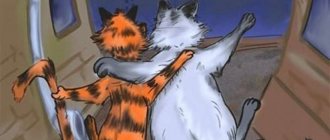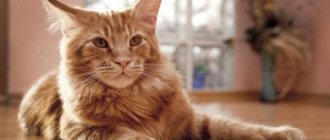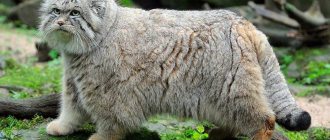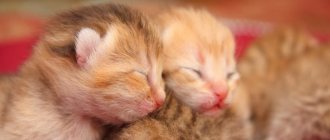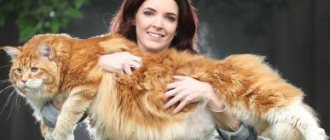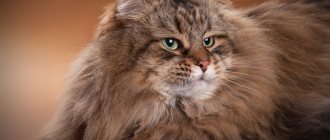Have you been given a kitten? Or did you decide to start it yourself? This is not important, the main thing now is to find out as many facts as possible from the life of this animal. A meowing creature will give you and your child a lot of positive emotions. And you will learn to correctly interpret its particular habits, understand your pet better and know a lot of useful things about its relatives. Interesting facts from the life of cats will be useful for adults and interesting for children. This will broaden the kids’ horizons and make them think about a lot. In this article we will list the most interesting facts about cats, their habits and tell you a lot of useful information.
A little about traveling cats
Did you know that these animals can travel not just long, but enormous distances to get to their home? Thanks to this feature, one cat from New York became famous, which the owner, due to his carelessness, forgot when moving to his old place. The animal found its owner on its own after 5 months, having covered 3.5 thousand kilometers! At the same time, the cat entered the house, as usual, jumped onto his favorite chair and curled up there. Such interesting facts about cats will allow children to understand how loyal these pets are.
In the same way, a Russian cat named Chapa became famous. He traveled with his masters to the sea, who lost him halfway. People were upset, but when they returned home, they found Chapa rested, but very dirty. The cat covered a distance of 1.5 thousand kilometers! When telling interesting facts about domestic cats to your children, explain at the same time how important friendship is in life, because even animals make such sacrifices!
Domestic cat
The ancestors of domestic pets were steppe and forest cats. Domestication occurred about 9.5 thousand years ago in the Middle East. From there, cats settled with people in other regions, where they protected grain reserves from rodents.
In Russian, the word cat means a domestic cat or a female cat. When denoting a male, they say about a cat.
Although the cat is a domestic animal, it is capable of surviving without human intervention and quickly goes wild. Feral cats can be aggressive and distrustful of people, but most are ready to find a “home” again.
Interesting things about pet health
Many people believe that cats wash themselves often because they are clean. Yes it is. However, this is not the only reason. This is also how the animal licks from the fur the amount of substance it needs, which contains vitamin B. It is also needed in order to regulate the cat’s mental balance. If you do not allow the animal to perform such a “ritual” for a long time, it will become very aggressive and may even die from stress.
How long do cats live? Interesting facts for children must contain this information. On average, a domestic pet can please you for a long 15 years (with proper care and good nutrition), while wild cats live less - 3-5 years.
Cat family
Wild cats are common on all continents except Australia and Antarctica, in regions with warm climates. In the taiga zone, only the Amur tiger, the Far Eastern leopard and cat, and the lynx have survived.
- Big cats: lion, tiger, leopard, snow leopard, jaguar.
- Small cats: cheetah, caracal, lynx, manul, several wild species, domestic.
Rice. 1. Wild jungle cat.
Human and cat health
It's no secret today that cats have a wonderful effect on people's health. A special study was conducted in the USA, the results of which are amazing - most doctors recommend that every person keep a pet in the house, preferably a cat. They believe that this is the ideal “recipe” for ridding people of many diseases. It has also been proven that purring creatures perfectly relieve stress and help get rid of fatigue.
Interesting facts about cats and cats don’t end there. According to research, the presence of this animal in the house can prevent a heart attack or stroke. To do this, just pet the fluffy - and the pressure will drop and the anger will go away.
"Interesting" anatomy and stuff
It is better to tell these interesting facts about cats to children if there is a pet in the house. This way the child will perceive information better and faster.
- Have you ever noticed the pattern on the surface of your pet's nose? Surely not. But you simply must know this - such a “pattern” is unique, just like a person’s fingerprints.
- The skeleton of a cat is formed by 230 bones, which is 24 more than that of a human!
- These animals do not have "normal" collarbones. Thanks to this anatomical feature, they can easily squeeze their body through the tiniest holes where their head can fit. You may have seen more than once how your pet checks a hole, trying to squeeze its head into some hole.
Interesting breeds
There are breeds developed by crossing wild and domestic cats:
- Bengal - a hybrid with wild Bengal;
- Savannah - crossbreeding with the African Serval.
In case of unusual mutations, they try to fix new characteristics. These are hairless sphinxes, Scottish folds, short-legged munchkins, and curly rexes.
Rice. 3. Bengal cat.
Incredible abilities and features
- The cat is a talented acrobat. Its front legs are designed by nature so that they can rotate in almost any direction, but both halves of the pet’s flexible body can move in completely opposite directions! Well, aren't these interesting facts about cats for children? Agree, not all adults know about this.
- The animal has five toes on its front paws and four on its hind paws.
- The cat's ear can rotate 180 degrees! Each of them has 32 muscles. It seems that pets can easily move their soft ears, but this action requires the use of 12 muscles!
- Some interesting facts about cats for children seem simply unimaginable, it is impossible to believe, but it is true. For example, this animal's hearing is better than that of a dog or a human. For comparison: we hear within 20 kHz, cats – 65 kHz.
Cats and mice
Facts about cats for children will be more entertaining if there is already a pet in the house. So hurry up and grab the purring “cure” and read on.
A cat can hear in the ultrasonic range! That is why its “ambush” near the little gray mouse’s hole is advisable even when the rodents “sit motionless.” After all, they communicate using ultrasound, and the cute predator doesn’t need more.
In just one year, this animal can save more than 10 tons of grain from mice.
For example, once upon a time about 600 cats lived in the Winter Palace of what is now St. Petersburg. Animals were settled there long before the revolution. According to some sources, their offspring still perform their duties there - catching mice.
In Austria there was once a fairly famous cat that guarded food warehouses from rodents. She did this so successfully that she was entitled to an old-age “pension” - she was constantly supplied with milk, meat, and broth.
As you can see, some interesting facts about cats for children also contain historical information, which also will not interfere with all-round development.
Stripe and jumpers
In a beautiful spacious house there lived a kitten, Striped.
He was a very cheerful and nimble kitten, and more than anything else he loved to play. Grandma will sit down to knit, and Stripe will climb into the basket, pull out a ball - and let's roll it on the floor. When children gather to play with toys, the kitten is right there: either he’ll hide in a castle made of blocks, or he’ll attach a doll’s bow to his tail, or he’ll decide to go for a ride in a truck. There are so many fun things to do outside! Stripe swam in a puddle with piglets, played hide and seek with little mice, looked for worms for the chickens, and even helped the puppy bark at passers-by. That's how much fun it was for the fidgety kitten!
One day Stripe woke up and wondered: what else could he play? All the games in the house are over, and so are the games outside. What to do? The kid climbed onto a high fence and began to look around. Suddenly he sees something green moving along the path. Jump-jump, jump-jump, jump-jump! "Wow! - thought the kitten. – I haven’t played jumping jacks yet. This must be so cool!”
Stripe quickly jumped off the fence and ran to meet his new friend.
- Who are you? - he asked and carefully touched the green jumper.
- I'm a frog. And who are you?
- And I'm a kitten. Can you teach me how to play bounce?
- What? – the little frog was surprised.
- Jumping and jumping! You jump so well: jump-jump, jump-jump! I want that too. Can?
“Of course,” the frog laughed. - Let's jump together. You need to sit down a little, then push off very, very hard with your hind legs and - jump-jump! - you are already in a new place. Catch up! - and the frog jumped along the path, and a small fluffy kitten jumped joyfully behind him.
So Striped learned to play a new game and found himself another friend. Do not believe? Then come to the lawn behind the house and watch how merrily two jumpers are jumping: jump-jump, jump-jump, jump-jump! Can you do that?
What history says
Although it is commonly believed that the ancient Egyptians were the first to domesticate cats, the oldest domesticated animal was found in a 9,500-year-old tomb in Cyprus. And this is more than 4000 years ahead of the information in Egyptian sources.
Pope Innocent VIII (these were the times of the terrible Spanish Inquisition) recognized these four-legged animals as assistants of the devil, as a result of which thousands of defenseless cats were burned at the stake. Unfortunately, such mass extermination led to a sharp increase in the number of rats, which made the consequences of the plague epidemic dire.
In the Middle Ages, these fluffy creatures were associated with black magic; on St. John's Day, they were cruelly stuffed into bags and then thrown into bonfires.
There is a Jewish legend that Noah prayed and asked God to save his ark and all its contents from an infestation of rats. In response to this, the Almighty made the lion sneeze, and then a cat jumped out of his mouth.
A little about vision
It turns out that of all animals, cats have the largest eyes in relation to their weight. If the animal were the size of a person, the eye would reach 4-5 cm in diameter. And most meowing creatures have no eyelashes.
Many are confident that cats are capable of seeing all the objects around them remarkably well in complete darkness. However, this statement is somewhat erroneous. Of course, in this case they see better than a person, but not perfectly. This feature is explained by the fact that the animal’s eyes have a special unique reflective layer that increases the amount of light falling on the retina. By the way, the cat doesn’t see anything right under its nose, which is why it takes so long to look for a tidbit if you put it right in front of it.
And if her pupils are dilated even in bright light, then she is in a playful mood or very interested in something.
Lifestyle
The cat is a nocturnal animal; it prefers to nap during the day and to walk and hunt in the evening and at night. For those who live in an apartment, this is inconvenient, but many cats get used to the rhythm of life of their owners.
- Free-roaming cats hunt mice, moles, frogs, and beetles. They love to play with a lump of soil, a dry leaf, and jump after butterflies. When kept in an apartment, an animal needs toys for movement.
- Hunting does not replace homemade food. Modern dry and wet food are designed for cats of different health conditions and ages.
- The design of cat paws allows the claws, which are constantly growing, to be retracted. During a walk, a cat wears its claws off on tree trunks; at home, you need a scratching post. Overgrown claws injure the pads, so they are trimmed.
- Cats with long hair need to be brushed regularly and tangles cut off.
A story about a cat would be incomplete without mentioning kittens. Usually 4–5 helpless, blind, deaf kittens are born. For convenience, the family is placed in a spacious basket or box, which is placed in a place where there are no drafts. By 10–11 days, kittens can see and hear. Breastfeeding lasts 8–10 weeks.
In Japan, Tashiro Island is home to more than 500 cats, with a local population of 70–100 people. The first cats were brought in in the 17th century to protect silk cocoons from mice and rats. Numerous tourists help maintain the cat colony.
Rice. 2. Island of cats Tashiro.
Interesting facts about cats
Children's development should be comprehensive and involve different forms of learning. But no matter how you talk about cats, it will be interesting in any case, the child will listen to you with eyes wide open in admiration.
Why does an animal sniff its bowl before eating? Don’t think too much, it is not mischievous and does not go through grub, as many believe, but does this in order to determine the temperature of the delicacy with its nose, so as not to get burned.
Four-legged purrs sleep approximately 18 hours a day, and they like to do this on paper, since this material is the softest and warmest for them.
When does a cat wag its tail? This happens when she is faced with a choice when one desire is blocked by another. For example, when an animal is in a doorway and is simply exhausted from the desire to go outside, but it is raining there, the tail will move due to an internal conflict.
A story about a cat for children 6-8 years old
A story about a cat for preschoolers and primary schoolchildren
About a pet.
Alechka is my favorite cat. Author: Bukarev Daniil, 8 years old, student of school No. 401, Kolpino St. Petersburg Leader: Efimova Alla Ivanovna, teacher of GBDOU No. 43, Kolpino St. Petersburg Purpose: message about a pet. Objectives: 1. Tell about your favorite pet. 2. Foster interest and love for animals. Description: use in working with preschoolers and first graders; for loving parents. Can be used for home reading. Today I want to tell you about my favorite – a cat.
Her name is Alya, and I affectionately call her Alechka. She is very beautiful, I photograph her often and love watching her. All so fluffy: black fur, white tie on his chest, white paws. In the morning she washes herself, or rather licks herself all over. She wakes up early and walks around waking everyone up with her meows. Alechka loves people very much. If guests come, she asks to be held by everyone.
My older sister brought my Alechka home when I was very little. I became very attached to her. In winter, my cat lives with me in the apartment, I like to play with her, feed her, give her milk and water. Alya loves sausage and fish. She is a very clean and smart cat. On winter evenings, dad is lying on the bed, Alechka will come up to him, meow so that she is allowed to jump on the bed, and only then she jumps. She loves to be petted. Mom feeds her, washes the potty, Alya runs after her mother with her tail. He rubs himself against his mother's legs as a sign of gratitude. Very funny. In the summer we go to live in the country and of course, I take my pet with me.
At the dacha, she loves to run, climb trees, and scratches her claws on the wooden fence. Alechka sometimes catches mice, catches them and carries them, puts them on the path and calls us to the owners so that we can look at her catch. I ask my mother to buy a collar for Alechka and put it on her. He protects her... I also go fishing with my dad and give the fish I catch to my cutie. I call my beloved cat Alechka, I’ll catch some fish for my beloved Alechka. I’ll go to the river with my dad and catch some fish for the cat. Alechka will eat to her fill and go to bed. She loves to sleep on her back, legs and belly up, and sleep herself.
I love my cat very much! I love to play with her, she hides from me, and I tie a piece of paper to a string and slowly pull the string, and Alechka runs after the rope with a candy wrapper. I also have a ball with a string, which I also use to play with Alya.
When I go to school, my parents go to work, my sister studies - Alya misses us. When we return, she meets us at the door. She meows as if she's crying that we left her alone. Alechka walks around the property like a housewife: she sniffs everything, goes into her mother’s greenhouse, and goes to visit the neighbors. She's an amazing cat. I love her so much. This is how wonderful my baby is.
We recommend watching:
A story about a dog A story about a hedgehog for children A story about a Goat for children A story about rabbits for children
Similar articles:
Stories about animals for children. Bathing the cubs
And that is not all…
- Biologically, a cat's brain is closest to a human's. In humans and in these loving pets, the same parts of the brain are responsible for emotions.
- Don't be surprised that your pet can jump to a height that is 5 times greater than its own height.
- When your pet rubs against you, do not think that she is doing it only out of affection. She wants to mark her territory (in this case, the owner) with the smell of the glands that are located around the muzzle. A similar odor is released from the paw and tail area.
- Scientists still cannot figure out exactly how a cat purrs. Some believe that this happens due to the vibration of the vocal cords, which are located deep in the purr's throat. To do this, the muscles located in the larynx close and open the air passage approximately 25 times per second.
- The animal's jaws are not able to move from side to side, so it cannot chew huge pieces of food.
- A cat's heartbeat is significantly different from a human's. The contraction frequency is approximately 110-140 beats per minute.
Project “My Favorite Cat” for primary schoolchildren
Natalia Zyurkalova
Project “My Favorite Cat” for primary schoolchildren
Dear colleagues, I present to your attention a project for junior schoolchildren that I prepared with my daughter Valeria.
Valeria is in second grade, and this year those interested in the class prepared projects for a scientific and practical conference. I invite you to get acquainted with our project and evaluate our work.
Project topic:
"My beloved cat Manya"
Slide 1
My project is called “My Favorite Cat”.
I like animals a lot. I have a cat at home - Manya, a turtle Totti and fish in an aquarium. But most of all I love cats. And I decided to find out more about her and tell her about my cat.
Slide 2
The purpose of my work: Find out what breed my cat is
Tasks:
Find out who cats are, how a cat became a domestic cat
find out what breeds of cats there are
Find out what role a cat plays in a person’s life
Observe your pet
slide 3
There is a cat in our family. Her name is Manya. She's 7. I remember her from my early childhood. She was brought into our family as a small kitten, when I was only a few months old. She is an affectionate cat. Manya loves to be where the whole family is.
Slide 4
Many years ago all cats were wild. It is difficult to determine when a person first started keeping a cat at home. There is an opinion that this animal was domesticated about 6 thousand years ago, when people, in addition to hunting and gathering, began to master cattle breeding and agriculture. People felt the need to save their harvest until next year. For this purpose, people had premises designed for storing grain and other products that had to be protected from rodents, which caused great damage to the household. The wild cat performed this duty best. However, scientists are still arguing about who, in fact, tamed whom - man cat or cat man. It is possible that the cat “domesticated” itself by hunting rodents and following people who quickly adopted these animals into their lives.
Slide 5
I learned that there are many breeds of cats. For example, the Persian cat . Cats of this breed are fluffy and have a depressed nose. The character of these cats is kind. I also recognized the Siamese cat breed
.
These cats are light-colored, but their faces and paws are dark. These are very smart cats, jealous and love their owner very much. There is a simple Russian blue cat
. She was named that way because her fur is blue.
There is also a sphinx
- This is a breed of hairless cats. They are like people, they like to sleep under a blanket because they get cold.
There are also cat breeds that look like dogs
. This is a dachshund cat and a cat poodle. The Ket Poodle is as curly as a Poodle.
Slide 6
A cat is a graceful, affectionate, cunning, but at the same time the most charming pet. She feels like the mistress of our home. She can be playful, calm, but still remains a predator.
Cats can communicate using the language of smell. A small, blind kitten will always find its mother thanks to its nose.
They mark their own territory and do not allow outsiders into it. Cats are independent, but they become very attached to the person and place of residence in which they live.
They help people get rid of rodents, thereby saving granaries, warehouses, barns and their own place of residence. These are the only animals that joined people of their own free will.
The role of a cat in a person’s life is very important. It takes on all negative impulses and cleanses the energy. When we stroke a cat, its hairs have a beneficial effect on the human nervous system.
A cat can calm a crying child, cheer him up, and play with him. When a child or adult is sleeping, the cat will warm him with its warmth.
Slide 7
After studying the literature, I found out that my cat is an ordinary Russian breed. Smooth-haired, black in color. She loves to eat fish, Whiskas, Kitikat and drink water. Manya loves to ride in a doll's stroller; she sleeps with me or with dad, or on a chair.
Manka has a favorite game called rubber band. She brings it in her teeth and puts it on the floor, and I or dad throws the rubber band and Manka runs after it, picks it up and carries it again. Manya is a very cheerful, playful cat. I love her so much.
Slide 8
While conducting research, I learned interesting facts from the life of cats.
1. Cats never meow to each other. This is a sound specifically for people.
2. The average lifespan of a domestic cat is 15-20 years
3. When the tail starts to droop, it means the mood has changed - you can move away, she won’t be offended
4. Cats see in twilight much better than humans. In bright light, a cat’s pupils are narrow, like slits. And with the onset of darkness, they expand.
Slide 9
From all of the above, we can conclude:
Cats are animals. They have excellent hearing and vision. They have curved, razor-sharp claws. Cats use their claws to catch and hold their prey. The fur covering the toes and soles of the paws helps them move silently. And my cat: an ordinary Russian smooth-haired cat. Black color. Pet, helper and healer.
slide 10
And in our city of Tyumen there is a cat alley, and everyone can visit it.
Thank you for your attention.
Do animals have a sixth sense?
Since ancient times, people have known about the incredible abilities of cats to foresee trouble, catastrophe, and natural disasters. For example, even before the wailing of very loud air force sirens, adults drag their young to secluded places. There are many cases in history when animals saved people in this way before earthquakes.
Have you ever noticed that if your pet rubs her ears hard, then it starts to rain heavily? No? Pay attention to this. The thing is that at this time a change in pressure occurs in the atmosphere, irritating the animal’s inner ear.
And cats anticipate earthquakes with the help of their sensitive paws and whiskers. With their help, they detect even the slightest vibrations in the soil.
These are the facts about cats. Study them with pleasure and take care of your pets!


